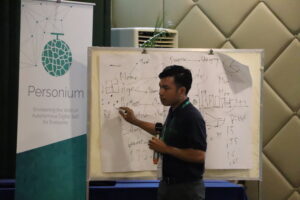Data Visualization
Data visualization is the graphical representation of data and information. It aims to facilitate an understanding of data insights and their patterns, trends, and relationships. Therefore, data visualization is more than just the visual presentation of concepts or workflows. It is essential because it helps people condense and interpret information from large datasets, and, additionally, it is visually more appealing than a raw dataset.
Vong Pisith, a Senior Data Research & GIS Officer at Open Development Cambodia (ODC), conducted an exciting and informative session on Data Visualization. It was one of the most popular sessions in the Cambodia ICT Camp 2022, with 40 participants, 14 of whom were women. Pisith talked about the importance of data visualization and data-driven storytelling and also discussed how to choose the most appropriate type of chart, things to consider when visualizing data, and tools for data visualization.

Data visualization is often used in data-driven storytelling to turn raw data into simple stories and present insights that are easy to read and understand. It is essential in presenting findings and new data insights with context because it can create simple narratives for complex information. Pisith also displayed a few graphs as examples of data visualization in data-driven storytelling.
Then, how to choose the right chart type was discussed. The speaker explained that it is crucial to narrow down the purpose of visualizing data into one of the following four categories: comparison, distribution, relationships, and composition. Pisith also suggested which charts can work best for each of the four categories since there are many types of charts. Users can choose variable-width column charts, tables with embedded graphs, bar charts, column charts, circular area charts, and line charts. At the same time, for distribution, Pisith suggested that going with column histograms, line histograms, scatter diagrams, and 3D area charts is a good idea. Scatter charts and bubble charts match are appropriate to show relationships between ideas. For composition, charts like stacked 100% column charts, stacked column charts, stacked 100% area charts, stacked area charts, pie charts, waterfall charts, and stacked 100% column charts with subcomponents were suggested.
Identifying the two types of attributes in the dataset is also necessary to visualize data. The qualitative attribute is divided into ordered (meaningful sequence or ranking) and unordered (names of things or symbols). The quantitative attribute focuses on discrete (finite values) and continuous (infinite values) attributes. Pisith said, “when visualizing data, we visualize to explore the insight, and we then visualize to explain the insight”. He also reminded participants that fooling the audience and distorting the message can happen easily when visualizing data. That can happen intentionally or unintentionally. In any case, caution is needed when observing visual forms of data.


At the end of the session, Pisith introduced some tools for data visualization, such as Flourish, Datawrapper, R Programming, Python, Google Sheets, and Microsoft Excel. He also demonstrated how Datawrapper works. Therefore, data visualization is a helpful tool for interpreting datasets more appealing to the masses. That can help convey complex messages on essential issues like digital security. For example, implementing the national internet gateway (NIG) will affect people’s fundamental liberties. Yet, many citizens might not be aware of it. With data visualization techniques, professionals can assess NIG’s impact, simplify complex messages, and present them to the masses to create awareness.


